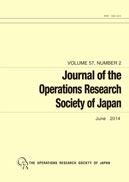Volume 40, Issue 4
Displaying 1-19 of 19 articles from this issue
- |<
- <
- 1
- >
- >|
-
Article type: Cover
1997 Volume 40 Issue 4 Pages Cover10-
Published: 1997
Released on J-STAGE: June 27, 2017
Download PDF (127K) -
Article type: Appendix
1997 Volume 40 Issue 4 Pages App7-
Published: 1997
Released on J-STAGE: June 27, 2017
Download PDF (100K) -
Article type: Article
1997 Volume 40 Issue 4 Pages 451-465
Published: 1997
Released on J-STAGE: June 27, 2017
Download PDF (1152K) -
Article type: Article
1997 Volume 40 Issue 4 Pages 466-478
Published: 1997
Released on J-STAGE: June 27, 2017
Download PDF (831K) -
Article type: Article
1997 Volume 40 Issue 4 Pages 479-488
Published: 1997
Released on J-STAGE: June 27, 2017
Download PDF (799K) -
Article type: Article
1997 Volume 40 Issue 4 Pages 489-508
Published: 1997
Released on J-STAGE: June 27, 2017
Download PDF (1329K) -
Article type: Article
1997 Volume 40 Issue 4 Pages 509-521
Published: 1997
Released on J-STAGE: June 27, 2017
Download PDF (1209K) -
Article type: Article
1997 Volume 40 Issue 4 Pages 522-535
Published: 1997
Released on J-STAGE: June 27, 2017
Download PDF (1118K) -
Article type: Article
1997 Volume 40 Issue 4 Pages 536-545
Published: 1997
Released on J-STAGE: June 27, 2017
Download PDF (745K) -
Article type: Article
1997 Volume 40 Issue 4 Pages 546-564
Published: 1997
Released on J-STAGE: June 27, 2017
Download PDF (1033K) -
Article type: Article
1997 Volume 40 Issue 4 Pages 565-578
Published: 1997
Released on J-STAGE: June 27, 2017
Download PDF (928K) -
Article type: Article
1997 Volume 40 Issue 4 Pages 579-589
Published: 1997
Released on J-STAGE: June 27, 2017
Download PDF (680K) -
Article type: Article
1997 Volume 40 Issue 4 Pages 590-600
Published: 1997
Released on J-STAGE: June 27, 2017
Download PDF (656K) -
Article type: Appendix
1997 Volume 40 Issue 4 Pages 601-603
Published: 1997
Released on J-STAGE: June 27, 2017
Download PDF (219K) -
Article type: Appendix
1997 Volume 40 Issue 4 Pages 604-
Published: 1997
Released on J-STAGE: June 27, 2017
Download PDF (65K) -
Article type: Index
1997 Volume 40 Issue 4 Pages 605-607
Published: 1997
Released on J-STAGE: June 27, 2017
Download PDF (155K) -
Article type: Appendix
1997 Volume 40 Issue 4 Pages App8-
Published: 1997
Released on J-STAGE: June 27, 2017
Download PDF (123K) -
Article type: Cover
1997 Volume 40 Issue 4 Pages Cover11-
Published: 1997
Released on J-STAGE: June 27, 2017
Download PDF (102K) -
Article type: Cover
1997 Volume 40 Issue 4 Pages Cover12-
Published: 1997
Released on J-STAGE: June 27, 2017
Download PDF (102K)
- |<
- <
- 1
- >
- >|
